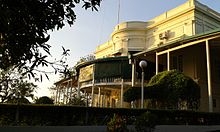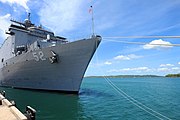
HMS Hermes was a British aircraft carrier built for the Royal Navy and was the world's first ship to be designed as an aircraft carrier, although the Imperial Japanese Navy's Hōshō was the first to be commissioned. The ship's construction began during the First World War, but she was not completed until after the end of the war, having been delayed by multiple changes in her design after she was laid down. After she was launched, the Armstrong Whitworth shipyard which built her closed, and her fitting out was suspended. Most of the changes made were to optimise her design, in light of the results of experiments with operational carriers.
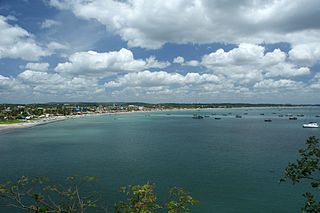
Trincomalee, also known as Gokanna and Gokarna, is the administrative headquarters of the Trincomalee District and major resort port city of Eastern Province, Sri Lanka. Located on the east coast of the island overlooking the Trincomalee Harbour, Trincomalee has been one of the main centres of Sri Lankan Tamil speaking culture on the island for nearly a millennium. With a population of 99,135, the city is built on a peninsula of the same name, which divides its inner and outer harbours. It is home to the famous Koneswaram temple from where it developed and earned its historic Tamil name Thirukonamalai. The town is home to other historical monuments such as the Bhadrakali Amman Temple, Trincomalee, the Trincomalee Hindu Cultural Hall and, opened in 1897, the Trincomalee Hindu College. Trincomalee is also the site of the Trincomalee railway station and an ancient ferry service to Jaffna and the south side of the harbour at Muttur.

The Indian Ocean raid, also known as Operation C or Battle of Ceylon in Japanese, was a naval sortie carried out by the Imperial Japanese Navy (IJN) from 31 March to 10 April 1942. Japanese aircraft carriers under Admiral Chūichi Nagumo struck Allied shipping and naval bases around British Ceylon, but failed to locate and destroy the bulk of the British Eastern Fleet. The Eastern Fleet, commanded by Admiral Sir James Somerville, was forewarned by intelligence and sailed from its bases prior to the raid; its attempt to attack the Japanese was frustrated by poor tactical intelligence.
After the outbreak of the Second World War, in the British Crown Colony of Ceylon, the government of Sir Don Baron Jayatilaka assured the British King and his government of its continued support.

Admiral Sir Geoffrey Layton, was a Royal Navy officer. He was in command of the submarine HMS E13 when, under attack from German vessels, it ran aground off the Danish coast during the First World War. Despite this incident, he rose to senior command in the Second World War and retired in 1947. His final appointment had been as Commander-in-Chief, Portsmouth.
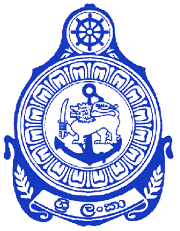
The Sri Lanka Navy (SLN) is the naval arm of the Sri Lanka Armed Forces and is classed as the country's most vital defence force due to its island geography. It is responsible for the maritime defence of the Sri Lankan nation and its interests. The role of the Sri Lanka Navy is to conduct operations at sea for the defence of the nation and its interests and conduct prompt and sustainable combat operations at sea in accordance with the national policies.
The Easter Sunday Raid was an air attack on Colombo, Ceylon during the Indian Ocean raid by carrier-based aircraft of the Imperial Japanese Navy on 5 April 1942. The Japanese objective was to destroy the Ceylon-based British Eastern Fleet in harbour. The British preemptively dispersed shipping from the harbours before the attacks due to advance warning from intelligence in March 1942, and air reconnaissance during the raid.

Naval and Maritime Academy (NMA), Trincomalee, is the naval academy of the Sri Lanka Navy, and is located within SLN Dockyard, Trincomalee. It received university status in 2001 under the leadership of Commodore SR Samaratunga.
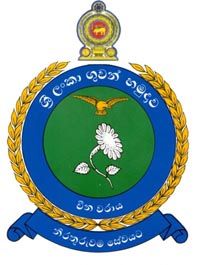
China Bay Airport is an air force base and domestic airport in China Bay in eastern Sri Lanka. Located approximately 7 km (4.3 mi) south west of the city of Trincomalee, the airport is also known as Trincomalee Airport and SLAF China Bay.
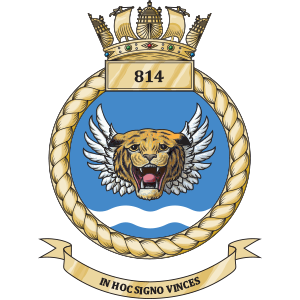
814 Naval Air Squadron or 814 NAS, nicknamed the Flying Tigers, is a squadron of the Royal Navy Fleet Air Arm. It is currently equipped with the AgustaWestland Merlin HM2 anti-submarine warfare helicopter and is based at Royal Naval Air Station (RNAS) Culdrose in Cornwall. The squadron was formed in December 1938 and has been disbanded and reformed several times.

The Hoods Tower Museum is a naval museum of the Sri Lanka Navy in Trincomalee. It is located at Ostenburg, in the Trincomalee peninsula on a high ridge overlooking the entrance to the inner harbor of Trincomalee within the SLN Dockyard. The museum gains its name from the Hoods Tower, an observation tower named after Vice-Admiral Sir Samuel Hood, Commander of the East Indies Station.

Trincomalee Harbour is a seaport in Trincomalee Bay or Koddiyar Bay, fourth largest natural harbour in the world and situated on the northeastern coast of Sri Lanka.

Navy House was the official residence of the Commander of the Sri Lanka Navy, located in SLN Dockyard, Trincomalee, Sri Lanka. It was formerly the official residence of the naval officer commanding, HM Dockyard, Trincomalee and later the Commander-in-Chief, East Indies Station of the Royal Navy.
The Trincomalee Garrison is a common name used for collection of military bases of the Sri Lanka Army located in and around the Fort Fredrick and the town of Trincomalee in the Eastern Province. Due to the large natural harbor, it is one of the oldest military garrisons in Sri Lanka and has been occupied by the Portuguese, Dutch, French and the British. Known as Trincomalee Fortress during World War II.
Vice Admiral Hikkaduwage Ananda Silva, VSV was a Sri Lankan senior naval officer who was the 11th Commander of the Sri Lankan Navy.

733 Naval Air Squadron was a Naval Air Squadron of the Royal Navy's Fleet Air Arm. It was active between January 1944 and December 1947, entirely in Ceylon, as a Fleet Requirements Unit, based mainly at R.N. Air Section China Bay, which became HMS Bambara, RNAS Trincomalee, China Bay, Ceylon. The squadron initially formed at R.N. Air Section Minneriya, at RAF Minnerya, Ceylon, two weeks after an advance party arrived there, remaining for three months after formation before relocating.

788 Naval Air Squadron was a Naval Air Squadron of the Royal Navy's Fleet Air Arm which last disbanded during June 1945. The squadron formed at RN Air Section China Bay in Ceylon, in January 1942, as the British Eastern Fleet's Torpedo Bomber Reconnaissance Pool, however it lost half its strength during the heavy raids by Japanese carrier-borne aircraft in the April. The squadron regrouped at RNAS Tanga in Tanganyika, East Africa to become a Fleet Requirements Unit and relocating almost immediately to RN Air Section Port Reitz, in Mombasa, where it remained operational for the next three years.
The Ceylon Royal Naval Volunteer Reserve was the volunteer naval reserve of the British Crown colony of Ceylon from 1938 to 1950. Established as the Ceylon Naval Volunteer Force (CNVF) on 1 January 1938 under the Naval Volunteer Ordinance, No, l of 1937. It was made up of volunteers mainly from the mercantile sector of Colombo consisting of 12 officers and 18 sailors, under the command of the newly commissioned Commander W. G. Beauchamp. The first headquarters of the force was set up on 11 January 1939, just before the outbreak of World War II, at Kochchikade.

